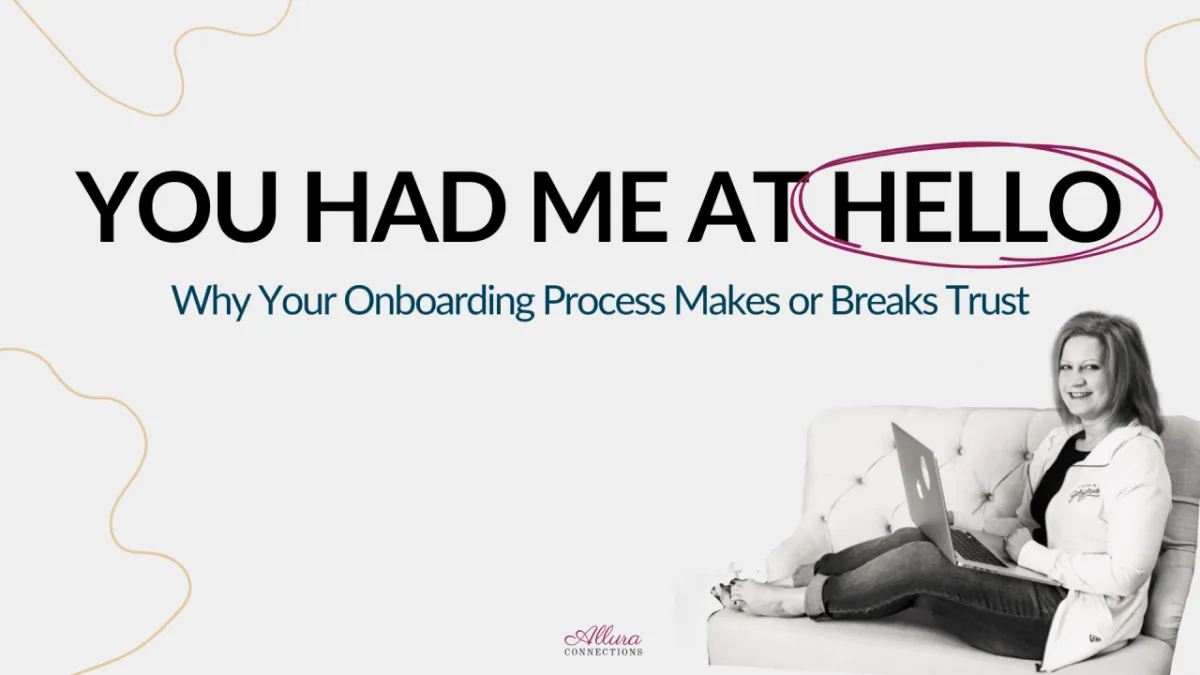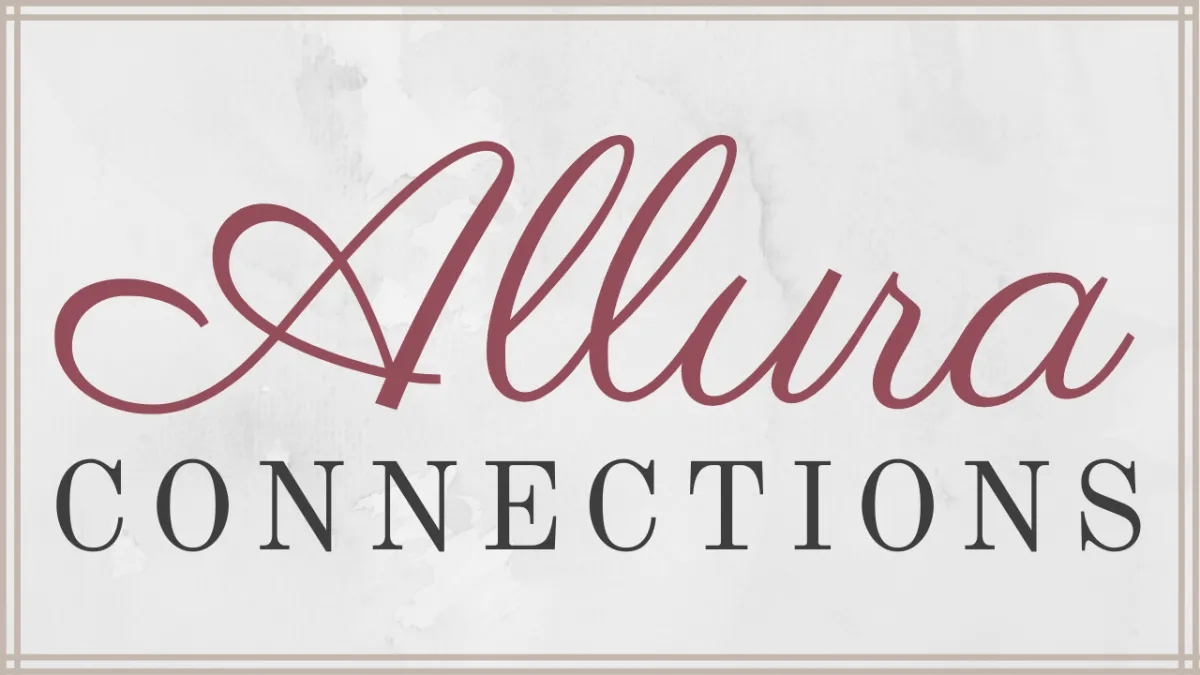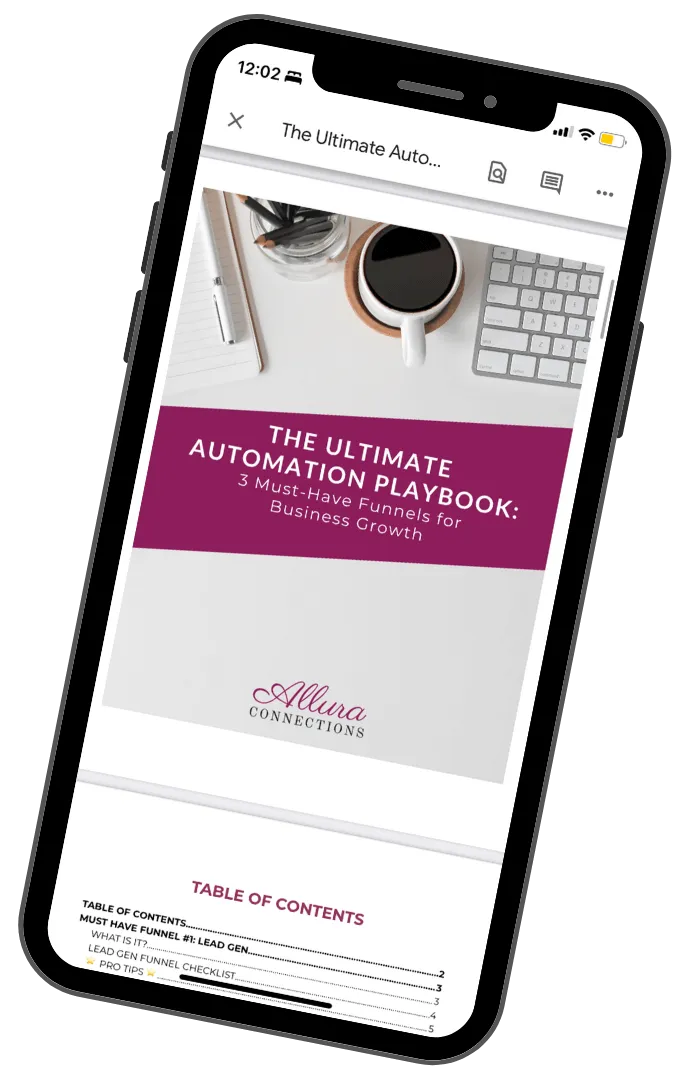
"You Had Me at Hello" – Why Your Client Onboarding Process Makes or Breaks Trust
They signed the contract.
They paid your invoice.
They're excited to work with you.
And then... radio silence for three days until you scramble to piece together their onboarding experience.
I know how this feels—that moment when you realize you're not as prepared as you thought.
First impressions happen only once, and for many of us as service providers, that critical moment is being wasted on chaos rather than building confidence.
When Your Expertise Isn't Enough
I've been noticing something happening with alarming frequency among talented business owners. You excel at your craft but might be stumbling at that crucial starting line with new clients.
While you're focused on delivering amazing results (which you absolutely can!), you might be overlooking how that jumbled, inconsistent onboarding experience sets the tone for the entire relationship.
Think about it from your client's perspective—when they receive different information, at different times, in different formats, it subtly signals that your business might be equally disorganized behind the scenes.
That's not the impression you want to create, especially when you work so hard to deliver exceptional service.
A Story You Might Recognize
I'd like to share a story that might feel familiar.
Meet Marina (not her real name, of course). As the owner of a thriving social media management agency, Marina was incredibly talented at creating content strategies that delivered real results for her clients. She'd grown from a solo freelancer to a team of four in just two years, with a solid reputation in her niche.
But beneath that success, Marina was drowning in the details of bringing on new clients.
Every time she signed someone new, she experienced what she jokingly called "onboarding amnesia." Without a standardized process, she relied on memory to determine what information to send, which forms to request, and which team member to loop in.
Some clients received welcome packets immediately, while others waited days.
Some got detailed instructions for providing access to their accounts, while others received vague requests, leading to confusion and those dreaded back-and-forth emails we all try to avoid.
Occasionally, Marina would realize weeks into a project that she had forgotten to collect critical information, forcing her to awkwardly circle back to clients who (understandably) wondered why she hadn't asked earlier.
Does any part of this sound familiar?
The Window Into Your Business Operations
As someone who specializes in helping entrepreneurs streamline their systems, I see this challenge all the time.
You're brilliant at your core offering but might be struggling with the operational foundations that support those client relationships from day one.
The truth is, your initial onboarding experience becomes a revealing window into how organized—or chaotic—your entire business operation appears to your clients. It sets expectations for everything that follows.
When Marina reached out to me, she described feeling constantly anxious about dropping the ball with new clients.
She knew her inconsistent onboarding was creating a poor first impression, and several clients had made comments about the confusing start to their working relationship.
What made it worse was that her team members were equally frustrated by the lack of clear processes, often duplicating efforts or missing steps entirely. They were working harder, not smarter.
Together, we mapped out her ideal client journey, identified every touchpoint in the onboarding process, and built a simple automated system that ensured consistency for every new client.
The transformation was remarkable—not just in client satisfaction but in Marina's own confidence.
She no longer dreaded signing new clients because she knew exactly what would happen next.
Her team operated with clarity, clients received a professional experience from their very first interaction, and Marina reclaimed hours of time previously spent reinventing the wheel with each new client.
I wanted to understand how widespread this challenge is, so I reached out to fellow business owners to hear their experiences with client onboarding. Their insights were eye-opening and might help you see your own onboarding process in a new light.
Learning From Those Who Excel at Client Onboarding
Adding a different perspective to this conversation...
Jenn Mullen, The Mindful Virtual Assistant, shares: "One of the first things I try to convey to a new client during our onboarding call (and even before on our Discovery Call) is that I truly care about their business just as much as they do. My goal is to gain their trust and have them let down their walls by providing results time and time again. When that happens, they get to see my work in action and experience real growth."
Jenn's approach highlights something crucial: onboarding isn't just about logistics—it's your first real opportunity to demonstrate genuine care for your client's success. That emotional connection forms the foundation of trust that will support your entire working relationship.
Emphasizing the critical nature of this challenge...
Jen Dys, Pinterest Marketing & Content Strategy specialist, offered this insight: "I want my clients to feel as though everything with their Pinterest or content is completely handled for them, and they just made the best investment ever with me. I do this by having all my onboarding steps in a workflow and templatized so that once a client signs to work with me, they get everything they need and they know exactly what to expect from me each week and month. Communication is huge too through the onboarding process and beyond."
Notice Jen's emphasis on systematization—"having all my onboarding steps in a workflow and templatized." This approach creates consistency while also freeing up mental space to focus on what truly matters: making clients feel secure and valued.
Stephanie Smith, Outsourced CFO shared: "I want clients to feel confident that choosing us was the right move and trust that we'll guide them effectively. We create that impression with a kickoff call to align on goals and priorities, set communication expectations, and deliver an immediate actionable next step."
Stephanie's focus on establishing immediate confidence and providing clear next steps shows how a structured approach can quickly validate the client's decision to work with you. By setting clear expectations and delivering immediate value, she ensures clients feel they're in capable hands from day one.
These conversations highlighted a common thread: the disconnect between how much business owners value their clients and how poorly their onboarding systems often reflect that value. This disconnect led me to reflect on several important questions that might help you examine your own client onboarding process.
Questions to Consider About Your Client Onboarding
How might your current onboarding process be silently undermining client confidence before you've had a chance to demonstrate your expertise?
Those initial interactions set the tone for the entire client relationship. When clients experience confusion, delays, or inconsistency during onboarding, they begin questioning—often subconsciously—whether working with you was the right decision, regardless of your expertise.
Consider this scenario: You've prepared meticulously for an important job interview but show up with coffee stains on your shirt and no copies of your resume. Your qualifications haven't changed, but the interviewer's perception of your professionalism is immediately compromised.
What systems could you implement that would transform your onboarding from a stressful scramble into a consistent, confidence-building experience?
Without intentional systems, each new client becomes a unique challenge requiring fresh mental bandwidth. This approach creates unnecessary stress, doesn't scale well, and inevitably leads to inconsistent experiences as your business grows.
Think of it this way: Creating a strong onboarding system is like developing a tested recipe instead of baking from memory each time. The recipe ensures consistent results while freeing your creativity for special touches that make the experience memorable.
How might the time you invest in automating your onboarding process today create freedom and growth for your business in the months ahead?
Many service providers view creating systems as a "someday" task rather than an essential foundation for sustainable growth. This mindset keeps you trapped in the cycle of working IN your business rather than ON your business.
Think about choosing between carrying water buckets from a river versus investing time to build a pipeline. The immediate work of carrying buckets feels productive, but you're limiting your long-term capacity and ensuring you'll always be tied to manual labor.
These questions reveal something critical about business growth that many service providers overlook: your expertise in your core service isn't enough to create a sustainable, scalable business. The operational foundations—particularly how you welcome and integrate new clients—can either support your growth or create a ceiling that limits your potential.
The Path Forward
What I've discovered through working with countless entrepreneurs like Marina is that the most successful businesses aren't necessarily those with the most talented practitioners.
Rather, they're the ones that create seamless, consistent client experiences from the very first interaction. When your operations match the quality of your core service, you create a solid foundation for sustainable growth.
The good news? This doesn't require complex technology or massive time investments.
Simple, thoughtful automation can transform your client experience while giving you back hours of time each week.
Here are three practical steps to begin improving your onboarding today:
Document your ideal process - Take 30 minutes to map out exactly what information, resources, and communications a new client should receive, and in what order.
Create templates for everything - From welcome emails to intake forms, having ready-to-use templates eliminates the need to recreate content for each client.
Set up one simple automation - Even if it's just an automated welcome email that triggers when a contract is signed, start small and build from there.
To dive deeper into these questions and discover practical solutions for creating an automated client onboarding system that runs without your constant attention, I'd love to connect. Feel free to reach out with questions about overcoming the operational challenges that keep your business dependent on your involvement.
Your clients deserve a seamless experience from day one, and you deserve the peace of mind that comes from knowing your systems are working for you—even when you're not.




